
The Hanover Stadtbahn is a Stadtbahn system in the city of Hanover, Lower Saxony, Germany. The Stadtbahn opened on 29 September 1975, gradually replacing the city's tramway network over the course of the following 25 years. Currently, the Hanover Stadtbahn system consists of 12 main lines, serving 196 stations, and operating on 121 kilometres (75 mi) of route. The system is run by üstra, which was originally an abbreviation for Überlandwerke und Straßenbahnen Hannover AG. As of 2007, it transported 125 million passengers per year.

Germany has an extensive number of tramway networks. Some of these networks have been upgraded to light rail standards, called Stadtbahn in German. Straßenbahn and Stadtbahn schemes are usually operated on the legal foundation of the BOStrab, the Tramways Act of Germany.

The Cologne Stadtbahn is a light rail system in the German city of Cologne, including several surrounding cities of the Cologne Bonn Region. The term Stadtbahn denotes a system that encompasses elements of trams as well as an underground railway network (U-Bahn) and interurban rail, even including three lines that are licensed as heavy rail and used by freight trains as well as Stadtbahn vehicles. Two of these lines connect the Cologne Stadtbahn to the Bonn Stadtbahn. These lines are jointly operated by both cities' transport authorities, resulting in both systems and the lines connecting them sometimes collectively referred to as Stadtbahn Rhein-Sieg.

The Stuttgart Stadtbahn is a semi-metro system in Stuttgart, Germany. The Stadtbahn began service on 28 September 1985. It is operated by the Stuttgarter Straßenbahnen AG (SSB), which also operates the bus systems in that city. The Stuttgart Stadtbahn is successor system of a tram network (Straßenbahnen) that characterized the urban traffic in Stuttgart for decades.
Leipziger Verkehrsbetriebe GmbH operates one of Germany's largest tramway networks. The tramway network history is presented below in tabular form, including opening, electrification, and closing dates by segment. Street names of the time are used in the tables, with current names in (parentheses).
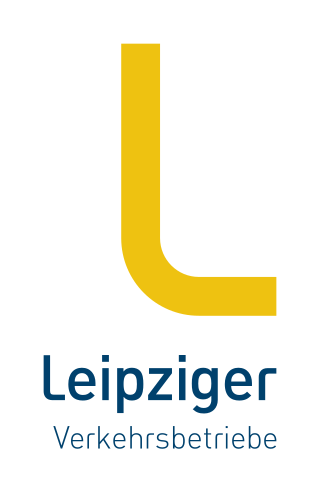
The Leipziger Verkehrsbetriebe (LVB), literally translated into English as the Leipzig Transport Authority, operates the tramway and bus transport services in Leipzig, Germany. The LVB network is a part of the regional public transport association, the Mitteldeutscher Verkehrsverbund (MDV). The LVB was formed by the merger, from 1 January 1917, of two predecessor undertakings, the Großen Leipziger Straßenbahn and the Leipziger Elektrischen Straßenbahn. The merged undertaking was also known as GLSt until it was reorganized and renamed as the LVB, from 29 July 1938.

Trams make an important contribution to public transport in the city of Zürich in Switzerland. The tram network serves most city neighbourhoods, and is the backbone of public transport within the city, albeit supplemented by the inner sections of the Zürich S-Bahn, along with urban trolleybus and bus routes, as well as two funicular railways, one rack railway and passenger boat lines on the river and on the lake. The trams and other city transport modes operate within a fare regime provided by the cantonal public transport authority Zürcher Verkehrsverbund (ZVV), which also covers regional rail and bus services.

The Karlsruhe Stadtbahn is a German tram-train system combining tram lines in the city of Karlsruhe with railway lines in the surrounding countryside, serving the entire region of the middle upper Rhine valley and creating connections to neighbouring regions. The Stadtbahn combines an efficient urban railway in the city with an S-Bahn, overcoming the boundary between trams and trains. Its logo does not include the green and white S-Bahn symbol used in other German suburban rail systems and the symbol is only used at stops and stations outside the inner-city tram-operation area.

The Dresden tramway network is a network of tramways forming the backbone of the public transport system in Dresden, a city in the federal state of Saxony, Germany. Opened in 1872, it has been operated since 1993 by Dresdner Verkehrsbetriebe (DVB), and is integrated in the Verkehrsverbund Oberelbe (VVO).

The Verkehrsbetriebe Karlsruhe is the municipal transport company of the city of Karlsruhe in Germany. It runs the tram and bus network within the city, as well as the Turmbergbahn funicular railway.

The Potsdam tramway network is a network of tramways forming part of the public transport system in Potsdam, the capital city of the federal state of Brandenburg, Germany.
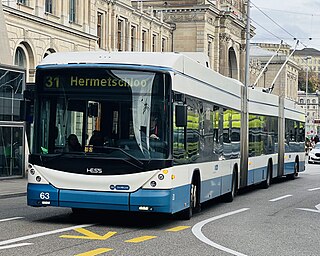
The Zürich trolleybus system is part of the public transport network of Zürich, Switzerland. Opened in 1939, it combines the Zürich S-Bahn, the Zürich tramway network and Zürich's urban motorbus network to form an integrated all-four style scheme.
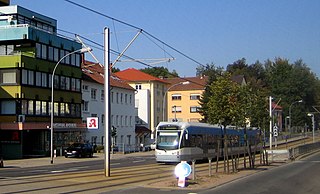
The Saarbahn is a regional Stadtbahn operating on the tram-train principle in the German state of the Saarland. It consists of a core line in Saarbrücken and Riegelsberg operating under tram operating procedures (BOStrab), connected to two lines that are operated under railway operating procedures (EBO), the Lebach–Völklingen railway to the north and the Saarbrücken–Sarreguemines railway in the south. Stadtbahn Saar GmbH is responsible for the infrastructure of the central section of line, while the outer tracks are operated by the national railway infrastructure companies, DB Netz AG in Germany and Réseau Ferré de France in France. The system is operated by Saarbahn GmbH, and integrated in the Saarländischer Verkehrsverbund (SaarVV).

The Freiburg im Breisgau tramway network is a network of tramways that forms part of the public transport system in Freiburg im Breisgau, a city in the federal state of Baden-Württemberg, Germany. Established in 1901, the network has been operated since its foundation by the company now known as Freiburger Verkehrs, and powered by electricity. The tramway network currently has five lines. The expansion of the tram network since 1980 has served as an example of the "renaissance of the trams" in Germany. As of 2023, 73 trams were available for regular use: 2 of these were high-floored, 36 partial and 35 low-floored. Almost the entirety of the network is located within Freiburg's urban area; only a few metres of the balloon loop at Gundelfinger Straße are located outside the boundary of Gundelfingen to the north of Freiburg. In total, the trams serve 20 out of the 28 districts in Freiburg.

The Essen Stadtbahn is a 19.6-kilometer (12.2 mi) light rail (Stadtbahn) network in Essen and the two neighbouring towns of Mülheim an der Ruhr and Gelsenkirchen in the German state of North Rhine Westphalia. It forms part of the Rhine-Ruhr Stadtbahn.

The Karlsruhe tramway network is a network of tramways forming part of the public transport system in Karlsruhe, a city in the federal state of Baden-Württemberg, Germany.

The Bonn tramway network forms part of the public transport system in the city Bonn, North Rhine-Westphalia, Germany, along with the Bonn Stadtbahn with which the tramlines are heavily integrated. The tram network consists of three tram lines which makes Bonn's tramway relatively small, as it comprises only 29.52 kilometres (18.34 mi) of route. The tramway is operated by 24 low-floor tramcars.

S-Bahn Erfurt was a colloquial term for a diesel-powered railway connection that existed from 1976 to 1995 in the Thuringian state capital Erfurt, Germany. The term "S-Bahn" is also occasionally used in popular literature. Other contemporary media used terms such as "suburban traffic at the local transport tariff" to describe it. When the line was introduced in 1976, only the "reversible train service" on this line was highlighted as a special feature. In the Kursbuch tables of Deutsche Reichsbahn, the terms "S-Bahn" or "S-Bahn-Tarif" were not used for this line. Riethschleuder was another colloquial term for the connection.
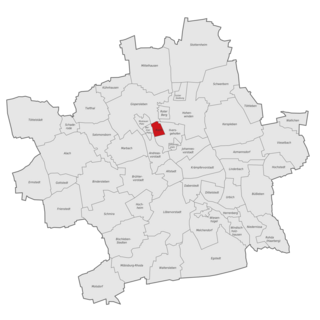
The Rieth is a district in the north of the Thuringian state capital Erfurt, Germany.
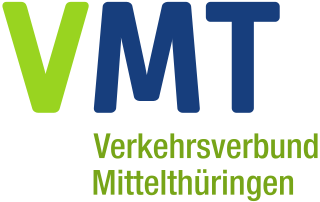
The Verkehrsverbund Mittelthüringen (VMT) is a transport association in central Thuringia, Germany. It comprises the cities of Erfurt, Weimar, Jena, and Gera, as well as parts of the districts of Weimarer Land, Sömmerda, Gotha, Ilm-Kreis, Saale-Holzland-Kreis, and Burgenlandkreis.



























